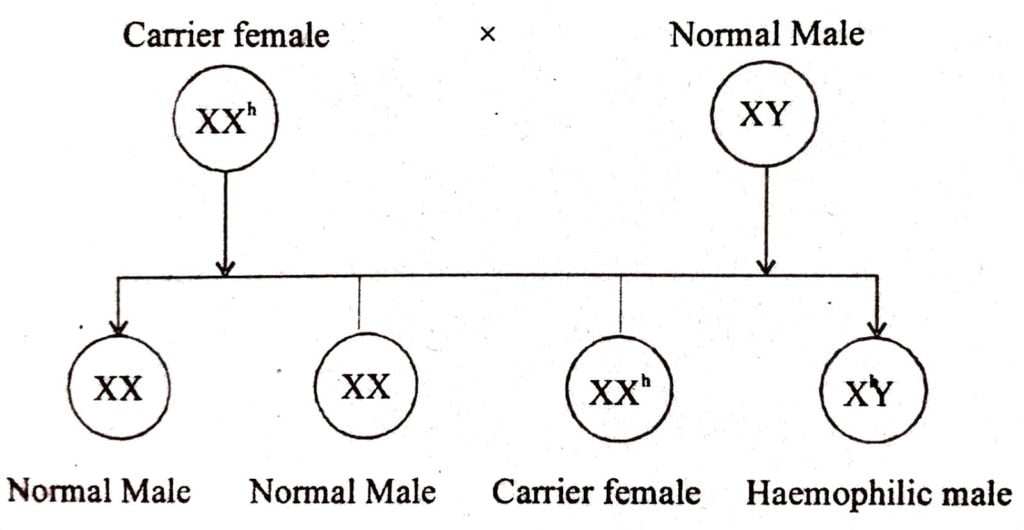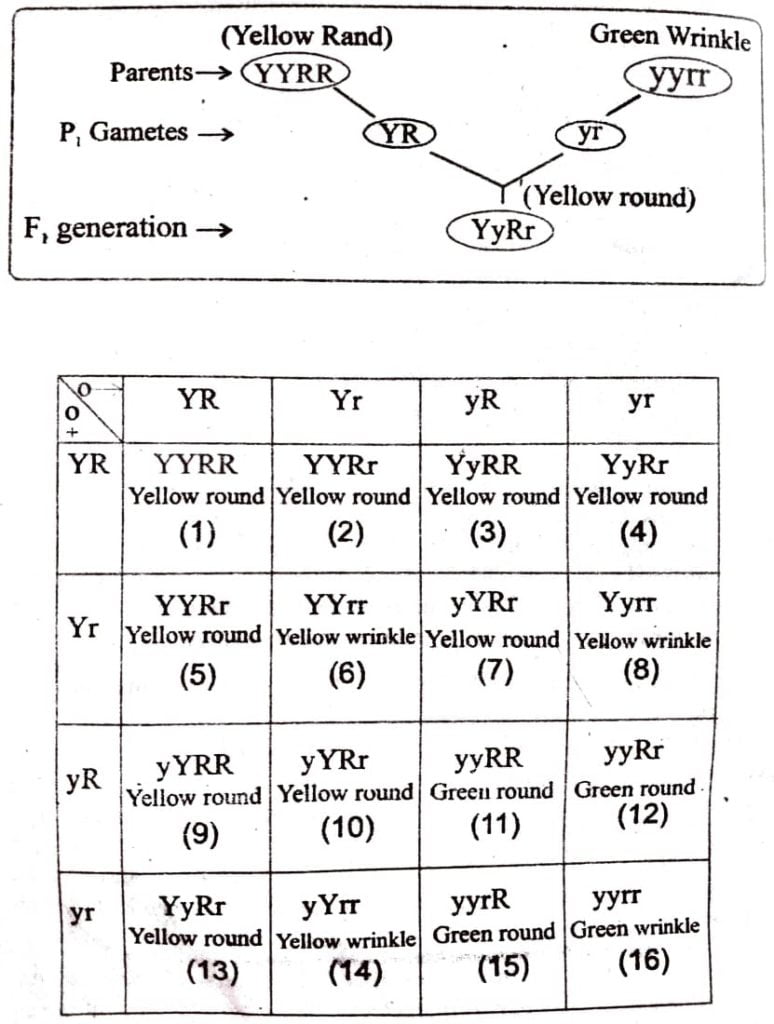Class 12 Biology Chapter 5 Principles of Inheritance and Variation The answer to each chapter is provided in the list so that you can easily browse through different chapters Assam Board HS 2nd Year Biology Chapter 5 Principles of Inheritance and Variation Question Answer.
Class 12 Biology Chapter 5 Principles of Inheritance and Variation
Also, you can read the SCERT book online in these sections Solutions by Expert Teachers as per SCERT (CBSE) Book guidelines. These solutions are part of SCERT All Subject Solutions. Here we have given Assam Board Class 12 Biology Chapter 5 Principles of Inheritance and Variation Solutions for All Subjects, You can practice these here.
(F). Long Answer Question (5 Marks) :
Q.1. Explain the inheritance of haemophilia in man.
Ans : Haemophilia : This is a disease occur due to sex-linked inheritance. It is called bleeder’s disease. It is caused by a mutant recessive gene (h) present on X-chromosome. In such disorder the blood lacks thromboplastin which helps in blood clotting. So in the absence of blood clotting substance a minor cut or injury may cause prolonged bleeding leading to death. A female may become haemophilic only when both the X-chromosomes carry the recessive gene. When the mutant gene is present in one of the X-chromosome the female becomes the carrier without being haemophilic herself. In male again if the X-chromosome carries the mutant gene then he becomes haemophilic because the corresponding Y-chromosome does not carry a corresponding dominant gene. Therefore, haemophilic disease is always caused by X-linked gene. It may also be called sex-linked inheritance.

Q.2. Describe the various kinds bene mutation.
Ans : Gene Mutations : Gene or point mutations are stable changes in genes i.e. DNA chain. Although each gene is a potential site for a mutation, yet some genes mutate more frequently then other genes. Such mutable genes are widely found in plants and animals. In bacteria spontaneously arising from gene mutations occur with a frequency of about one in 10⁶ gene duplications. Many times a change in a gene or nucleotide pair doesn’t produce detectable mutation. Thus the point or gene mutation means the process by which new alleles of a gene are produced. The smallest part of gene that can mutate is called muton. The smallest muton in a gene is a single base pair of DNA.
Sickle cell anaemia arises due to a change of amino acid glutamine to valine in the sixth position of B. chain of haemoglobin.
Q.3. How is sex determined in human beings?
Ans : The same XX-XY method of sex determination is found in human. In human the diploid cells contain 46 chromosomes (23 pairs). Of these, 44 chromosomes are autosomes and the other 2 chromosomes are sex- chromosomes. The pair of sex-chromosomes may be constituted either.
by a pair of XX chromosomes or XY chromosomes. Male diploid cells contain 44+XY chromosomes and female diploid cells contain 44+XX chromosomes. So the sperms contain 22+X (50%) or 22+Y (50%) sets of chromosomes. But the eggs always contain 22+X (100%) sets of chromosomes. Therefore, when sperm with 22+X unites with egg having 22+X the resultant zygote is produced with 44+XX chromosomes. Thus the offspring becomes a female baby. On the contrary if sperm carrying 22+Y chromosomes unites with the egg having 22+X chromosomes the zygote that is produced developes into a male baby (44+XY). Therefore the Y-chromosome takes leading part in determination of sex. In the absence of Y chromosome the baby is female and in its presence the baby is a male.

Q.4. How would you distinguish between Klinefelter’s syndrome and Turner’s syndrome?
Ans :Turner’s Syndrome : A female with one chromosome shows Turner’s syndrome. Such males are sterile, of short stature, webbed necked and with short hair and have low intelligence.
Klinefelter Syndrome : This syndrome develops when abnormal egg have XXY chromosomes. In such case an abnormal male child is born. Such child will have small testicles, longer arms, low breast, high pitched voice. They are also mentally retarded.
Q.5. Write an account of Mendel’s experiments.
Ans : Gregor Johann Mendel was born in 1822 in a village of Heinzendort (new czechoslovakia) and in 1857 he began his famous experiment on peas in monastery garden. He considered pea (Pisum sativum) for his experiment because.
(a) It was easy to cultivate.
(b) Many contrasting characters.
(c) Prefers cross as well as self pollination.
(d) Result can be obtained within short period only.
(e) Flowers were bisexual.
Mendel considered the following character only :
(1) Seeds Smooth Wrinkled
(2) Colour of seed Yellow Green
(3) Height of plant Tall Dwarf –
(4) Portion of flower Axial Terminal
(5) Seed coat White Grey
(6) Endosperm/cotyledon Yellow Green
Mendel kept notice of each character separately and carefully in each and every generations during the course of his experiment.
Mendel first crossed pea plants differing in a single pair of contrasting characters, such as tallness and dwarfness, smooth seeded and wrinkled seeded, yellow seeded and green seeded etc. He called the initial cross between two varieties as parental or P₁ generation. The offspring of the P₁ generation were found to bear the character of one of the parents only and not of both. For example, a cross between tall and dwarf plants, always produce tall plant in F₁ generation. The contrasting characters never mix up. F₁ generation is the offspring of P₁ generation. When Mendel observed that in F₂ generation the contrasting characters were not evident he allowed the plants of F₁ generation to self-pollinate.
He collected all the seeds and sown them to produce F₂ generation. He noted with great interest that in F₂ generation the contrasting character came out in the proportion of 3: 1. That was out of every 4 plants 3 plants showed the character of one of the parent of P, generation and the other one showed the character of the other parent. He noted with interest that out of the 3 plants, which showed dominant character did not breed true. Out of the 3 plants only one breed pure and the other-2 segregated in the ratio of 3 :1 again. But out of the 4 plants in F₂ generation the one which showed only recessive character did not segregate but breed true to its type.
The above facts can be explained taking into consideration of one pair of contrasting characters. For example, in P₁ generation the contrasting characters are tallness and dwarfness. They were pure tall and dwarf respectively as they breed true to their types generation after generation having in them the tallness of both the parents and dwarfness of both the parents. Their charactery therefore can be represented as TT and tt respectively. The tall (TT) and dwarf (tt) will produce gametes T and t respectively. These two gametes after fertilization will produce offspring in the F₁ generation which will exhibit tallness. The dwarfness will remain latent in them as it will contain both characters T and t in its gametes.
If these plants are allowed to self-pollinate then in F, generation tallness and dwarfness will be segregated in the ratio of 3: 1. The plants carrying the characters- TT, Tt and Tt will all be tall act being dominant characters). The other plant receiving tt character will be pure dwarf. Out of the TT, Tt and tt plants the TT will breed pure tall plants and the Tt and Tt will breed again in the ratio of 3:1. Mendel called this as Monohybrid Ratio and the cross between the plants in which one pair of contrasting character were taken was called Monohybrid cross. TT and Tt show different genetic characters (genotype) but same visible character (phenotype).
Q.6. Give an account on chromosomal disorders.
Ans : Various genetic diseases are known which are caused by abnormality of the autosomal chromosomes (not connected with determination of sex). Autosomal abnormality may be due to polyploidy (more than normal diploid set of chromosomes) or may be due to aneuploidy (one chromosomes may be more or less than the normal). Aneuploidy has several forms. Sometime 21st pair of 18th pair or 13th pair of chromosomes fail to separate during meiosis. Fertilization between one normal gamete and one abnormal gamete with nondisjunction chromosome gives rise to individual having one extra chromosome such as 3 sets of 21st or 18th or 13th chromosome. This phenomenon is called trisomy.
Similarly one chromosome of 21st pair or. 18th pair may be deleted. In such condition the diploid cell will contain one chromosome less. This phenomenon is called monosomy. In trisomic condition the body cells contain 47 chromosomes (one chromosome more) but in monosomic condition the body cells contain 45 chromosomes (one chromosome less). Abnormality of sex chromosome also causes genetic diseases of many types. Three or more sets of sex-chromosome results form non-disjunction of sex chromosome during gamete formation. The normal pair of sex- chromosome in human is either XX or XY. But due to abnormality the sex-chromosomes set may be XXY or XYY or XXXY etc.
Genetic disorder may also be caused by change in the sequence of gene in chromosome. Change in the sequence of gene may be caused by mutagenic agents or may be due to loss of genes by accidental breakage of chromosomal part or it may be due to addition of genes by attachment of broken chromosomal part with another chromosomes.
Some inherited diseases have been briefly mentioned below :
(i) Down’s Syndrome : This syndrome is also called mongolism. In the middle aged female the 21st pair of chromosome may not be able to separate during oogenesis. Thus a fertilized agg may contain 3 sets of 21st chromosome. Thereby total chromosomes in the diploid nucleus becomes 47 instead of normal 46. A child having 3 sets of chromosome number 21 (trisomy-21) may suffer from physical and mental defects. Mental retardation is severe in such case. They may have below average height, widely separated eyes, flattened nose, short but broad feet etc.
(ii) Monosomy-21 : If the fertilization egg is devoid of complete set of 21st chromosome the body cell will contain 45 chromosomes. Loss of one chromosome will produce a monosomic child with large ears and closely placed eyes.
(iii) 18-Trisomy : A Child having 3 sets of 18th chromosome possesses laterally flas head and the helix of the car scarcely develops. The hands are short and show little development of the second phalanx.
(iv) 13-Trisomy : A child having 3 sets of 13th chromosome shows severe body and organ malformation. Such children are also mentally retarded. Head is small and eyes are often very small or absent.
Genetic Disorders :
(i) Mendelian Disorders :
(a) These are mainly due to alternation or mutation in single gene.
(b) The disorder may be dominant or recessive.
(c) These may be metabolic abnormalities.
(i) autosomal (eg. sickle-cell anaemia, phenylketonuria)
(ii) sex-linked (eg. haemophilia, colour blindness)
(ii) Chromosomal Disorder :
(a) These may be due to excess of certain chromosome or abnormal arrangement or structural defect of certain chromosome.
(b) Some of the more serious disorders-Down’s syndrome, Klinefelter’s syndrome, Turner’s syndrome.
Q.7. Give an note on phenylketonuria.
Ans : It is a Mendelian disorder. It causes metabolic disorder due to non production of specific enzyme at particular time of the relation. This happen when the gene controlling certain enzyme become in effective due to mutation. As enzyme is available for conversion of certain substrate it accumulates and cause metabolic malfunctioning.
Phenotypic expression in individual depends upon the end product of a particular series of reaction where a large number of enzymes take part and for which a large number of genes are involved. In the following scheme, it may be noted that in the normal phenylalanine metabolism if block appears at step 1, phenylalanine will not be converted to tyrosine and as a result of which the reaction will not proceed further. Phenylalanine will accumulate in excess in blood resulting into a disease called phenylketonuria (mental retardation, pale skin, epileptic tendency). Similarly blockage at step 4 causes excessive accumulation of homogentisic acid that passes through urine. Oxidation of homogentisic acid by air turns urine black. The disease is called alkaptonuria.
Phenylalanine → tyrosine → p-hydroxyphenylpyruvate → homogentisic acid → male-ylacetoacetic acid → fumarylacetoacetate acid → fumaric acid→ acetoacetic acid → citric acid cycle.
Q.8. What is pedigree analysis? Suggest how much an analysis can be useful?
Ans : Pedigree analysis is an analysis of the distribution and movement of traits in a series of generation of a family.
It is useful. Because :
(i) It is an important method to study human genetics.
(ii) Genetic disorders occurring in a family can be identified and the movement of the trait in the future generation can be predicted.
Q.9. Mention any two autosomal genetic disorder with their symptoms.
Ans : Two autosomal genetic disorders are :
(i) Down’s syndrome : The main symptoms are rounded face, broad fore-head, permanently open mouth, protruding tongue, projecting lower lip, short neck, broad palm with characteristic palmar crease and Mongolian type eye-lid fold.
(ii) Phenylketonuria : It is an inborn error of metabolism. The effected individual lack an enzyme called phenylalanine hydroxylase that converts the amino acid phenylalanine into tyrosine. As a result of this phenylalanine is accumulated and converted into phenylpyruvic acid and other derivatives. Accumulation of this in brain causes mental retardation. There are also excreted through urine due to their absorption be kidney.
Q.10. Explain the law of Independent assortment using Punnett square.
Ans : The law of Independent assortment states that the genes of different characters created in different pairs of chromosomes are in dependent of one another in their segregation during gamete formation (meiosis), The principle of Independent assortment can also be defined as ‘ If we consider the inheritance of two or more genes at a time, their distribution in the gametes and progeny of subsequent generations is independent of each other.
In the dihybrid cross that each pair of characters (alletes) behave independently of other pair of characters. One character has no influence on another character and assort independent of other.The dihybrid ratio and independent assortment of alleles can be represented schematically and the ratio is 9:3:3:1

(i) Yellow round – 1,2,3,4,5,7,9,10,13 = 9
(ii) Yellow Wrinkle – 6,8, 14 = 3
(iii) Green round – 11, 12, 15 = 3
(iv) Green wrinkle – 16
One Word Technical Terms (Special 1 Mark Question)
Q.1. Genes which code for a pair of contrasting traits.
Ans : Allele.
Q.2. Alteration of DNA and subsequent changes in genotype phenotype.
Ans : Mutation.
Q.3. Trisomy of 21 chromosome.
Ans : Down’s syndrome/Mongolism.

Hi, I’m Dev Kirtonia, Founder & CEO of Dev Library. A website that provides all SCERT, NCERT 3 to 12, and BA, B.com, B.Sc, and Computer Science with Post Graduate Notes & Suggestions, Novel, eBooks, Biography, Quotes, Study Materials, and more.


